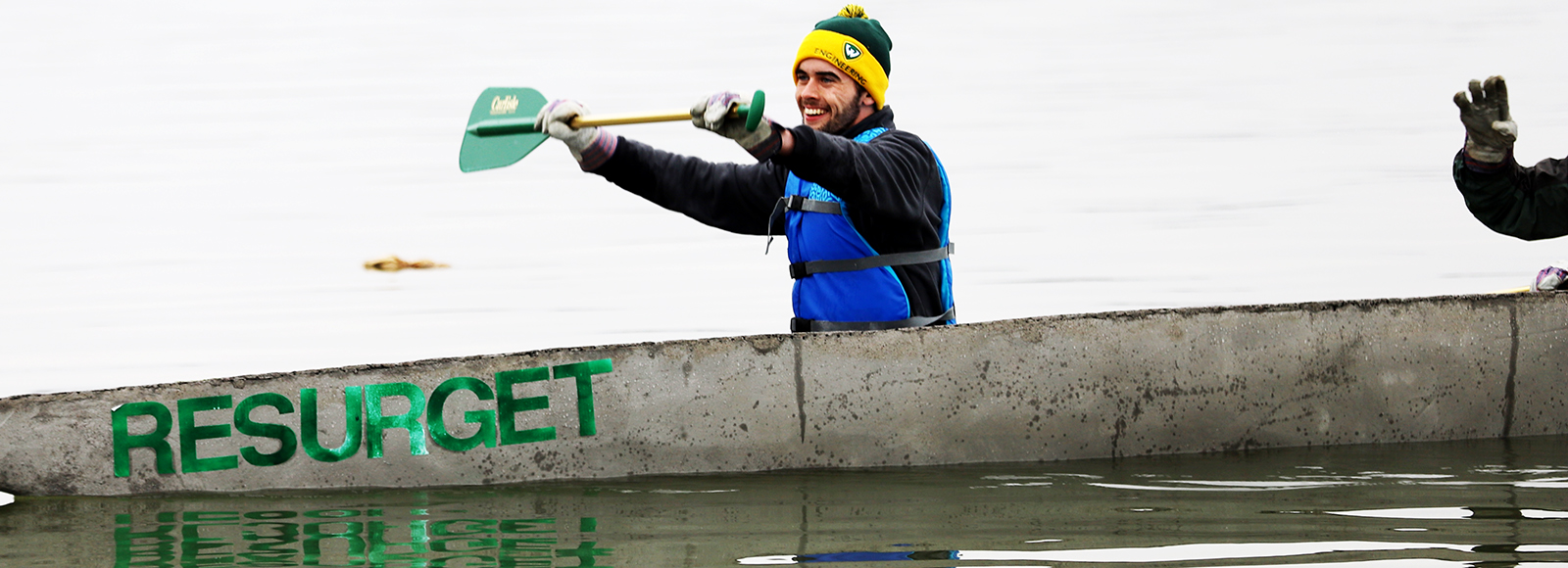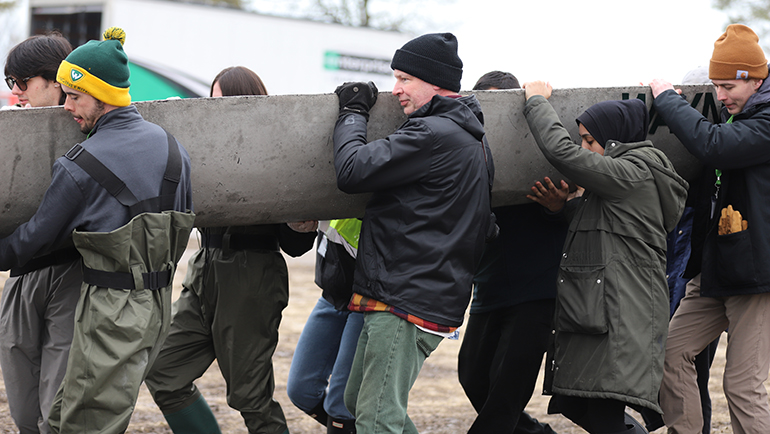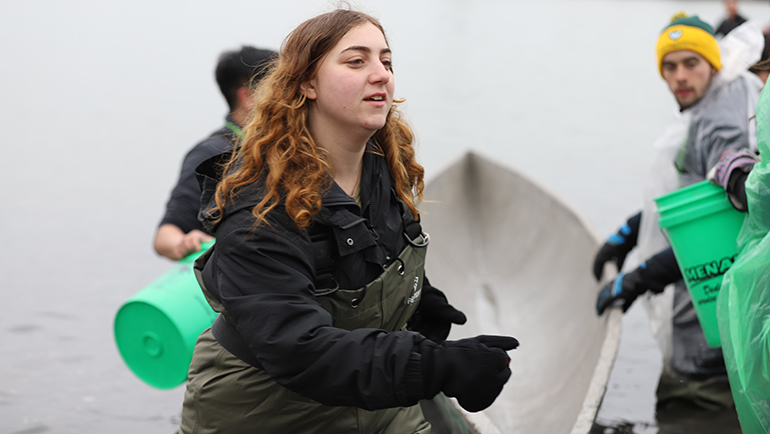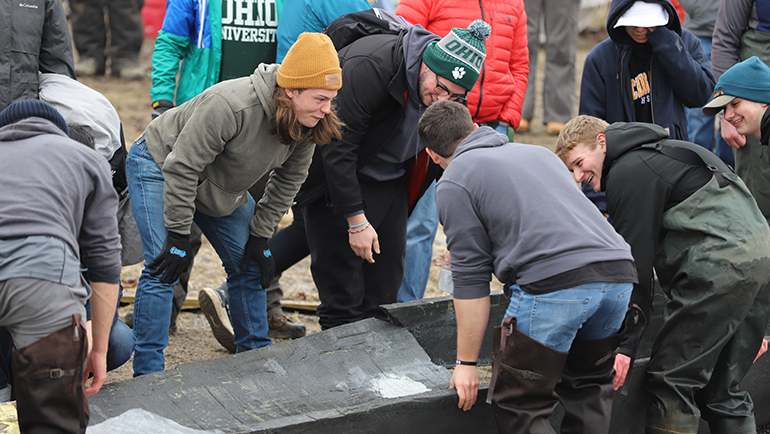
HARRISON TOWNSHIP, MICHIGAN – They didn’t post the fastest times, yet Friday, March 31, was still a rock-solid victory for a dozen Wayne State students at Lake St. Clair Metroparks.
Racing in the Eastern Great Lakes regionals of the Concrete Canoe Competition, Wayne State’s team was delighted with the performance of its 280-pound nautical vessel.
“We’re happy with the times because we didn’t know what to expect,” said senior co-captain Knicko Mojica. “This was our first time taking the boat on to the water, so, honestly, we’re pretty happy with how it all went.”
Nearly 400 students and supporters gathered on the banks of Lake St. Clair to witness the races and cheer on the competitors. The event – sponsored by the American Society of Civil Engineers (ASCE) and hosted by Wayne State – featured 12 teams from Michigan and Ohio that showed their engineering excellence, hydrodynamic design, racing technique and, of course, concrete canoes.
The all-day event included buoyancy testing and culminated with the men’s and women’s 200-meter slalom races. This was the first time in three years that Wayne State entered a boat into the regional event.

Despite the damp and dreary weather, Wayne State professor Bill Shuster, Ph.D., was beaming with pride.
“This is inspiring,” said Shuster, chair of the civil and environmental engineering department and faculty advisor for the school’s ASCE student chapter. “I get a lot of energy from the students, and we’re hitting it out of the park. We’re an urban-serving university and there’s no better place to meet the challenge than at Wayne State.
“What an effort it’s been in hosting this event, but what a joy to see everybody coming together having such a good time and celebrating what it is to be an engineer.”
Shuster, who spent 17 years as a research hydrologist with the Federal Environmental Protection Agency in Cincinnati, said a great deal of planning and design went into making the canoes buoyant and fast.
“There is some complex interaction with about 5% air in there, and you have buoyancy and surface tension, all kind of interacting to support what seems to be an impossible boat to float,” he said. “But sure enough, the ingenuity of the student designers and good, solid principles of construction materials are all practiced to keep the boat light and floatable.”
Although each team devoted months of preparation for Friday, there was some heartbreak. Ohio Northern University and Ohio University suffered catastrophic structural damage to its canoes and never made it to the starting line. Another vessel, piloted by the University of Cincinnati, capsized during the women’s race. The Macomb County Sheriff Marine Division pulled the two Bearcats out of the water and Wayne State volunteers dragged the canoe to shore.

Youngstown State University took first place in both men’s (2:17.13) and women’s (2:30.60) races.
Wayne State’s women were led by senior Logan Ballard of White Lake and junior Grace Gutierrez of Wyandotte, who crossed the finish line in 4:44.25. The men were guided by juniors Kennedy Taylor of Detroit and Kelvin Selegean of Clinton Township, who finished in 4:52.15.
Other members of Wayne State’s team who played critical roles included seniors Bayaan Odeh, of Plymouth; Koleta Barauskas, of Clawson; co-captain Ebby Alhakam, of Dearborn Heights; and juniors Samuel Stafford, of Grosse Pointe; Ellen Pierce, of Sterling Heights; Noah Richendollar, of Belleville; and Timothy Kosinski, of Wyandotte.
Though they finished in fourth and seventh place in the women’s and men’s races, respectively, Mojica, a Warren native, was thrilled with the outcome of the Warriors’ efforts, which began with the planning stages last September.
“We came in with no expectations, and obviously we had no prior experience,” he said. “I think we have come a long way. It definitely wasn’t a straight line. There were times when we thought it was going so well, and then there were times when we were questioning whether or not we would make it to the water. But being here and seeing how it went for some of the other schools, it’s a great feeling for us.”

For Shuster, watching his students achieve success with their concrete canoe gives him hope for things to come in the future.
“Our civil and environmental engineering students – across all of these universities – are the folks that will be building, rebuilding and restoring our infrastructure,” he said. “I think we all understand that we have serious infrastructure issues, so based on what I see here, it’s incredible to see them practicing all of these basic core skills to complete a floatable project.
“In one way or another, core skills have been practiced in this project to bring it all together and this is what these engineers will be doing every day for us as a society. These are the folks we’re going to depend on.”
An urban-serving university, @WayneStateEng hosted nearly 400 students at the @ASCETweets Concrete Canoe Competition, racing their 280-pound nautical vessel along Lake St. Clair. https://t.co/hzxJXEnvlC
— Wayne State News (@WayneStateNews) April 3, 2023
Here are the final results from Friday’s men’s and women’s 200-meter slalom races:
The Men’s Race
1. Youngstown State University, 2:17.13
2. Michigan Technological University, 2:30.15
3. University of Michigan, 3:17.65
4. Western Michigan University, 3:40.12
5. Lawrence Technological University, 4:17,71
6. University of Akron, 4:50.15
7. Wayne State University, 4:52.15
8. University of Cincinnati, 5:23.04
9. University of Toledo, 5:45.55
10. Ohio State University, 11:21.80
The Women's Race
1. Youngstown State University, 2:30.60
2. Michigan Technological University, 2:40.12
3. University of Michigan, 4:01.11
4. Wayne State University, 4:44.25
5. University of Akron, 5:03.22
6. Western Michigan University, 7:30.18
7. Lawrence Technological University, 9:26.99
8. Ohio State University, 14:02.75
9. University of Toledo, 14:38.55
10. University of Cincinnati, DQ
